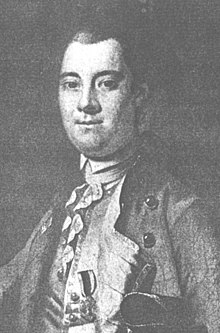William Tryon
|
His Excellency William Tryon |
|
|---|---|

Alleged portrait, 1767. This portrait depicts incorrect regimental uniform and ornamentation.
|
|
| 39th Governor of New York | |
|
In office 1771–1780 |
|
| Monarch | George III |
| Preceded by | Cadwallader Colden |
| Succeeded by | James Robertson |
| 8th Governor of North Carolina | |
|
In office 1765–1771 |
|
| Monarch | George III |
| Preceded by | Arthur Dobbs |
| Succeeded by | James Hasell (acting) |
| Personal details | |
| Born |
June 8, 1729 Norbury Park, England |
| Died | January 27, 1788 (aged 58) London, England |
| Spouse(s) | Margaret Wake |
| Religion | Church of England |
William Tryon (June 8, 1729 – January 27, 1788) was a British soldier and colonial administrator who served as the eighth Governor of North Carolina (1765–1771) and the Governor of New York (1771–1780).
Tryon was born 8 June 1729 at the family's seat at Norbury Park, Surrey, England the son of Charles Tryon and Lady Mary Shirley.
In 1751, he entered the military as a lieutenant in the 1st Regiment of Foot Guards and was promoted to Captain in later that year. He had a daughter by Mary Stanton, whom he never married. In 1757, he married Margaret Wake, a London heiress with a dowry of 30,000 pounds. Her father, William Wake, had been the Honourable East India Company's Governor in Bombay from 1742 to 1750, and had died on a ship off the Cape of Good Hope on the voyage home. In 1758, he was promoted to lieutenant colonel. Margaret was later the namesake of Wake County, North Carolina, where Raleigh, North Carolina is located.
During the Seven Years' War, he and his regiment were involved in the Cherbourg-St. Malo operation. They landed at Cherbourg and destroyed all war making facilities. In September, they reembarked for St. Malo where the operation went smoothly until the withdrawal when they came under intense fire from the French at the Battle of St Cast. Tryon was wounded in the thigh and in the head.
On 26 April 1764, through family connections, he obtained the position of acting lieutenant governor of the Province of North Carolina. He arrived in North Carolina with his family, including a young daughter, and architect John Hawks, in early October to find that the previous governor, Arthur Dobbs, had not left. He said that he would not be leaving until May. Tryon found himself with no income (although he was Lieutenant Governor). In 1765, a house called Russelborough on the Cape Fear River near Brunswick Town was renovated to serve as Tryon's residence while he acted as Lieutenant Governor. Tryon assumed his position as acting governor when Dobbs died on 28 March 1765. On 10 July, the King promoted him to governor.
...
Wikipedia
